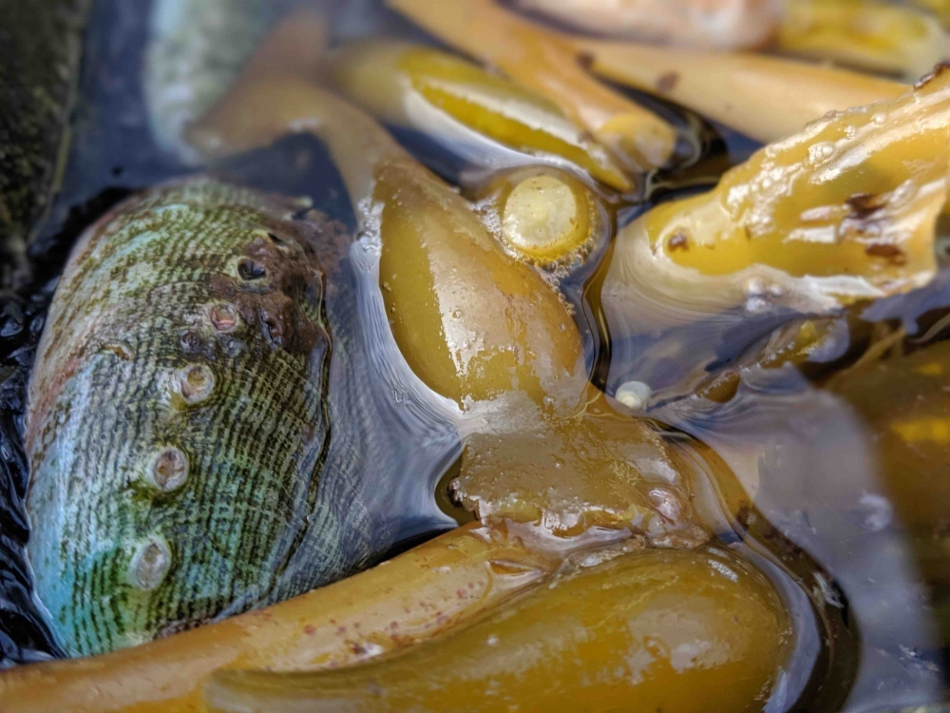Aug 4 2020
Humans’ appetite for seafood is increasing with the rising population and the growing trends of a better standard of living across the world.
 A red abalone hides under a frond of giant kelp at the Cultured Abalone Farm in Goleta. Image Credit: Halley E. Froehlich.
A red abalone hides under a frond of giant kelp at the Cultured Abalone Farm in Goleta. Image Credit: Halley E. Froehlich.
Consumption of seafood products touched an all-time high in 2020, with every individual on the Earth consuming an average of 20 kg every year.
Until now, most seafood was caught in the oceans and freshwaters around the world. However, things are changing, and at present, 50% of all seafood consumed comes from aquaculture or farmed sources. It is believed that the industry will increase by two-fold by the year 2050 to meet the growing global demand.
Halley E. Froehlich, an assistant professor from the University of California, Santa Barbara (UC Santa Barbara), was involved in the assessment of the intricate interactions between environmental, animal health, and human parameters of this emerging sector, a view dubbed as the One Health framework by researchers.
Published in the Nature Food journal, the study brings together a varied group of sociologists, economists, and scientists, as well as policy specialists headed by the Centre for Sustainable aquaculture futures. The center is a joint initiative between the University of Exeter and the Centre for Environment, Fisheries, and Aquaculture Science in the United Kingdom.
Aquaculture is now being more widely recognized as an important part of our global food system. And it will continue to grow. So the question is, how do we plot that course in a more sustainable way?
Halley E. Froehlich, Assistant Professor, Departments of Environmental Studies and Ecology, Evolution, and Marine biology, University of California, Santa Barbara
Aquaculture has contributed significantly to improving the lives of millions of poor people residing in several low- and middle-income countries, but it also encounters a series of sustainability challenges.
These challenges include the release of disease agents, overuse of antibiotics, degradation of the environment, and the need for wild-caught fish oil and fish meal to produce feed. Moreover, parts of the sector engage in gender inequality and poor labor practices.
These examples create negative societal impressions that conceal the possibly significant advantages of aquaculture. From a nutrient point of view, farming cold-blooded animals is extremely efficient. Several species such as oysters can survive without feeding. Besides, aquaculture can function on a smaller footprint when compared to several other forms of food production.
The latest article makes use of the One Health framework to provide a set of metrics to include in national aquaculture methods across the world to enhance sustainability as the sector grows.
These strategies include ideas such as quality employment and access to nutritious food, the health of ecosystems and wild fish stocks, resilience to climate change, and maintaining a small environmental footprint.
As the sector grows, coordination, cooperation, and communication will be crucial to the sustainable development of aquaculture.
If you don’t have that knowledge transfer—for instance, from scientists to policy-makers or farmers to scientists—these types of framework structures won’t go anywhere.
Halley E. Froehlich, Assistant Professor, Departments of Environmental Studies and Ecology, Evolution, and Marine biology, University of California, Santa Barbara
Keeping that aspect in mind, the study’s authors extensively collaborated on this report.
“The paper results from extensive interaction between a wide range of academic experts in aquaculture, health, environmental and social sciences, economists, industry stakeholders and policy groups,” stated the study’s senior co-author Charles Tyler from the University of Exeter.
The study presents a new method for developing aquaculture and also the benchmarks to which individuals will quantify its success and sustainability.
This is an important paper, acknowledging that aquaculture is set to deliver most of our seafood by 2050, but also that sustainability must be designed-in at every level.
Grant Stentiford, Study Lead Author, Centre for Environment, Fisheries and Aquaculture Science
The One Health framework serves as a tool for governments to consider when creating policies.
Stentiford added, “I hope it will become a blueprint for how government and industry interact on these issues in the future. Most importantly, it considers aquaculture’s evolution from a subject studied by specialists to an important food sector—requiring now a much broader interaction with policy and society than arguably has occurred in the past.”
According to Froehlich, who has started to shift her focus toward the U.S. industry, particularly California, a few of these principles are already being used in Norway and the European Union.
At present, Froehlich is in the middle of a Sea Grant project gathering the most extensive dataset of marine aquaculture information collected from all coastal states in the United States. This dataset includes policies, practices, and concealed interactions with fisheries that impact how aquaculture is carried out in every state.
“Aquaculture is everywhere and nowhere at the same time. People don’t realize how integrated it is into so many facets of marine ecology, conservation biology, and fisheries,” Froehlich concludes.
Journal Reference:
Stentiford, G. D., et al. (2020) Sustainable aquaculture through the One Health lens. Nature Food. doi.org/10.1038/s43016-020-0127-5.